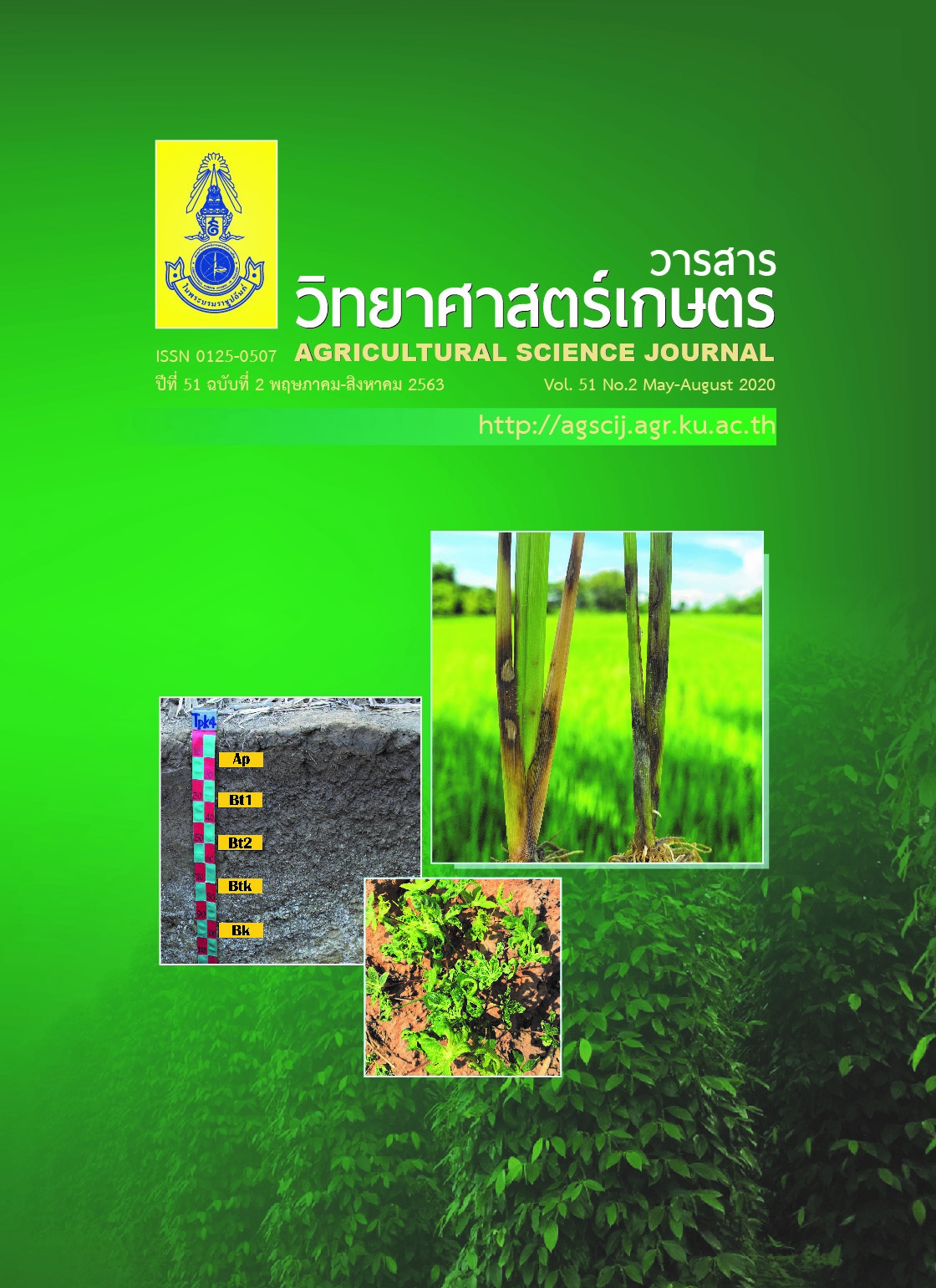การจัดการข้อจำกัดในชั้นสมรรถนะความอุดมสมบูรณ์ของดินร่วนปนกรวด (Ldr+ km) เพื่อการปลูกอ้อยในจังหวัดสระแก้ว
Main Article Content
บทคัดย่อ
การจัดการข้อจำกัดของดินตามชั้นสมรรถนะความอุดมสมบูรณ์ของดินร่วนปนกรวด (Ldr+km) ที่ใช้ปลูกอ้อยเพื่อเป็นแนวทางในการเพิ่มผลผลิตและคุณภาพอ้อยและการปรับปรุงผลิตภาพของดิน การศึกษานี้มีวัตถุประสงค์เพื่อศึกษาการจัดการดินตามชั้นสมรรถนะความอุดมสมบูรณ์ของดินเพื่อลดข้อจำกัดของดินในหน่วย Ldr+km สำหรับการปลูกอ้อย ทำการศึกษาในแปลงทดลองในหน่วยดิน Ldr+km ซึ่งมีข้อจำกัดในการปลูกอ้อย ได้แก่ ดินมีปริมาณอินทรียวัตถุ (m) และปริมาณธาตุอาหารในดินต่ำ (k) มีกรวดปะปนในดิน (r+) และมีความเสี่ยงต่อการขาดน้ำในฤดูแล้ง (d) โดยทำการศึกษาต่อเนื่องในอ้อยปลูกและอ้อยตอพันธุ์ขอนแก่น 3 วางแผนการทดลองแบบบล็อกสุ่มสมบูรณ์ (RCBD) 4 ตำรับการทดลอง 4 ซ้ำ ได้แก่ T1 = ตำรับควบคุม, T2 = ใส่ธาตุอาหารรองและจุลธาตุอาหาร, T3 = ใส่ธาตุอาหารหลัก, T4 = ใส่ธาตุอาหารหลักธาตุอาหารรองและจุลธาตุอาหารร่วมกับวัสดุปรับปรุงดิน เก็บตัวอย่างดินก่อนและหลังการทดลองเพื่อการวิเคราะห์สมบัติทางฟิสิกส์และเคมีของดิน เก็บข้อมูลการเจริญเติบโตของอ้อยทุก 2 เดือน และ ผลผลิตอ้อยที่อายุ 12 เดือน ผลการศึกษาพบว่า การใส่ปุ๋ยธาตุอาหารและวัสดุปรับปรุงดินตามตำรับการทดลอง ส่งผลให้สมบัติดินหลังการทดลองไม่แตกต่างกัน แต่ทำให้ผลผลิตอ้อยต่างกันอย่างมีนัยสำคัญทางสถิติ เฉพาะในอ้อยตอ โดย T4 ให้ผลผลิตอ้อยสูงที่สุดเท่ากับ 13.37 และ 13.23 ตันต่อไร่ ในอ้อยปลูกและอ้อยตอ ตามลำดับ เมื่อพิจารณาผลตอบแทนหลังหักค่าปุ๋ย พบว่า ไม่มีความแตกต่างกันระหว่างตำรับการทดลอง
Article Details
เอกสารอ้างอิง
Ashraf, M.Y., F. Hussain, J. Akhter, A. Gul, M. Ross and G. Ebert. 2008. Effect of different sources and rates of nitrogen and supra optimal level of potassium fertilization on growth yield and nutrient uptake by sugarcane grown under saline conditions. Pak. J. Bot. 40: 1521–1531.
Attanandana, T. and J. Chanchareonsook. 1999. Practice and Handbook of Soil and Plant Laboratory Analysis. Department of Soil Science, Faculty of Agriculture, Kasetsart University, Bangkok. (in Thai)
Bolbol, H., M.K. Eghbal, H. Torabi and N. Davatgar. 2013. Fertility capability classification of paddy soil in comparison with the soil taxonomy in Guilan province, Iran. Intl. J. Agric: Res & Rev. 3: 873–880.
Bray, R.A. and L.T. Kurtz. 1945. Determination of total organic and available from of phosphorus in soil. Soil Sci. 59: 39–45.
Calcino, D., B. Schroeder, J. Panitz, A. Hurney, D. Skocaj, A. Wood and B. Salter. 2018. Australian Sugarcane Nutrition Manual. Sugar Research, Australia.
El-Tilib, M.A., M.H. Elnasikh and E.A. Elamin. 2004. Phosphorus and potassium fertilization effects on growth attributes and yield of two sugarcane varieties grown on three soil series. J. Plant Nutri. 27: 663–669.
Hansud, R. and W. Kaewpradit 2020. The influence of zinc sulphate (ZnSO4) application on growth and total soluble solid in juice of sugarcane grown under sandy soil. Prawarun Agr. J. 17: 11–20. (in Thai)
Jackson, K.L. 1965. Soil Chemical Analysis Advanced Course. Department of Soils, University of Wisconsin, USA.
Kheoruenromne, I. 2005. Soil Survey Concept and Techniques. 2nd edition. Department of Soil Science, Kasetsart University, Bangkok. (in Thai)
Khon Kaen University. 2018. Knowledge for Sugarcane Development. Office of Cane and Sugar Board. Available Source: http://www.ocsb.go.th/upload/learning/fileupload/5336-7406.pdf, September 26, 2020.
Masoud, H., A. Mousa and N.M. Javad 2018. Different K:Ca ratios affected fruit color and quality of strawberry ‘Selva’ in soilless system. J. Plant Nutri. 4: 243–252.
Moody, P.W. and P.T. Cong. 2008. Soil Constraints and Management Package (SCAMP) Guidelines for Sustainable Managements of Tropical Upland Soils. Australian Center for International Agricultural Research, Australian Government, Australia.
Nguyen, H.H., S. Maneepong and P. Suraninpong. 2017. Effects of potassium, calcium, and magnesium ratios in soil on their uptake and fruit quality of pumelo. J. Agric. Sci. 12: 110–121.
Office of Cane and Sugar Board. 2019. Sugarcane Plantation Area Report 2018/19. Ministry of Industry, Bangkok. (in Thai)
Office of Cane and Sugar Board. 2020. Report of Sugarcane Situation Planting 2019/20. Ministry of Industry, Bangkok. (in Thai)
Prasithikhetra, J. 1999. Soil and fertility management base on soil analysis for crop, pp. 159–180. In Handbook for Fertilizer Use Base on Soil Analysis. Maruay Garden Hotel, Bangkok. (in Thai)
Sanchez, P.A., W. Couto and S.W. Buol. 1982. The fertility capability soil classification system interpretation application. Geoderma 27: 283–309.
Sanchez, P.A, C.A. Palm and S.W. Buol. 2003. Fertility capability soil classification: a tool to help assess soil quality in the tropics. Geoderma 114: 157–185.
Singh, A., R.N. Srivastava and S.B. Singh. 2003. Effect of nutrient combinations on sugarcane productivity. Sugar Tech. 5: 311–313.
Sritongchim, S., B. Thaneerat, A. Sukasem and S. Saelim. 1997. Management of Skeleton Soil. Department of Land Development, Ministry of Agriculture and Cooperative, Bangkok. (in Thai)
Tawornpruek, S., P. Pinjai, N. Chittamart, T. Darunsontaya, R. Chareaonsri, R. Lertpayakarat, S. Watana and K. Homyamyen. 2015. Fertility capability classification and soil productivity index for sugarcane growing soils in Eastern Thailand, pp. 1–67. In Development of Soil Quality and Productivity Index for Sugarcane Growing in Eastern Thailand. Research Report RDG5650105. Thailand Research Fund. (in Thai)
Tawornpruek, S., N. Chittamart, T. Darunsontaya, R. Chareaonsri, S. Watana, K. Homyamyen and D. Waijaroen. 2018. Development of soil management approach according to fertility capability classification units and soil productivity indices for sugarcane growing soils in Sakaeo province, pp. 1–42. In Studies on Soil Management According to Productivity Potential, Sugarcane Trash and Utilization of Soil Microbial Activities to Maintain Soil Quality and to Increase Sugarcane Yield and Quality in Sa Kaeo Province. Research Report RDG5850008. Thailand Research Fund. (in Thai)
Thai Meteorological Department. 2018. The Climate of Sa Kaeo Province. Climate Center of Development Metrological Office, Thai Meteorological Department, Bangkok. (in Thai)
Thai Meteorological Department. 2019. The climate of Sa Kaeo Province. Climate Center of Development Metrological Office, Thai Meteorological Department, Bangkok. (in Thai)
Thomas, G.W. 1982. Exchangeable cations, pp. 161–163. In C.A. Black, ed. Method of Soil Analysis Part II Chemical and Microbiological Properties. 2nd edition. Agronomy No.9 Amer. Soc. Agron. Inc, Madison, Wisconsin, USA.
Viets, Jr. F.G. and W.L. Lindsay. 1973. Testing soils for zinc, copper, manganese and iron. pp. 153–172. In L.H. Walsh and J.S. Beaton, eds. Soil Testing and Plant Analysis. Soil Science Society of America, Inc, Madison, Wisconsin, USA.
Vutikamolchai, B., P. Kanlayasilapin, W. Niponkit, P. Sirideach, S. Sawetwech and J. Tisawat. 2015. Integrated testing of sugarcane varieties and sugarcane production technology in eastern Thailand. pp. 103–107. In Test and Development on Sugarcane Production Technology for Specific Area. Department of Agriculture, Thailand. (in Thai)
Walkley, A. and C.A. Black. 1934. An examination of degtjareff method for determining soil organic matter and a proposed modification of the chromic acid titration method. Soil Sci. 37: 29–35.
Weil, R.R. and N.C. Brady. 2017. The Nature and Properties of Soils. 15th edition. Pearson Education, Inc., New Jersey, USA.
Wood, R.A. 1990. The roles of nitrogen phosphorus and potassium in the production of sugarcane in South Africa. Fertilizer Res. 26: 89–98.
Zalewska, M., J. Wierzbowska and A. Nogalska 2017. Effect of basic cation saturation ratios on the Mg, K and Ca content of annual ryegrass (Lolium multiflorum L.). J. Elem. 22: 1507–1523.


